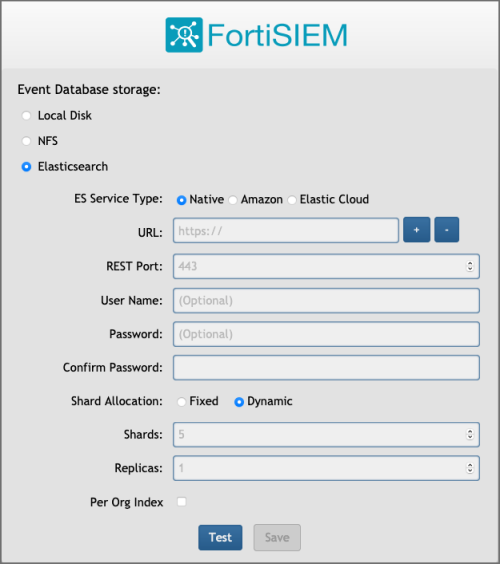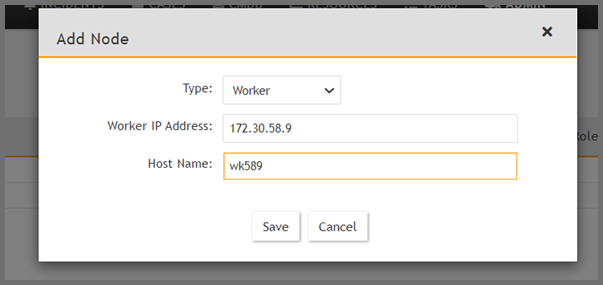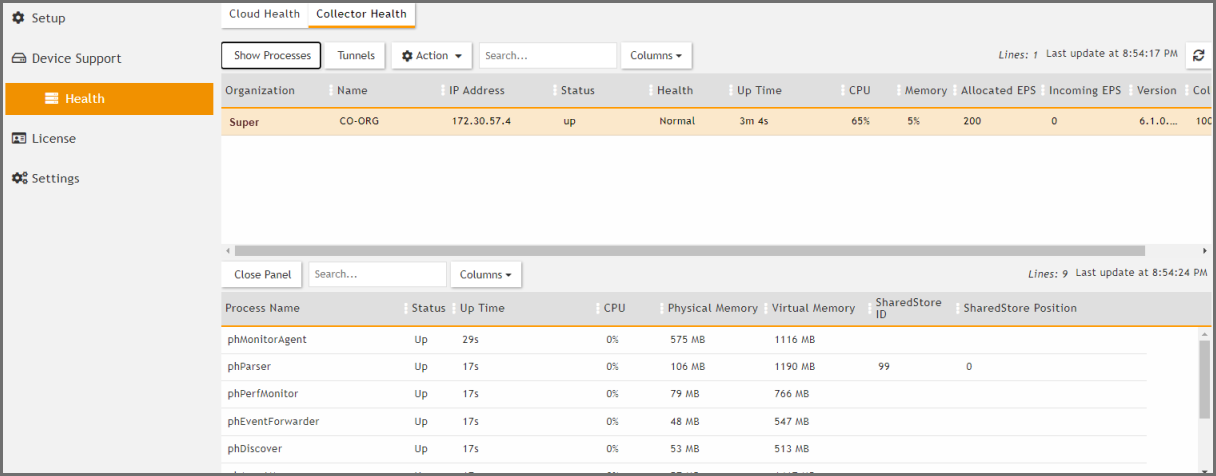Fresh Installation
Pre-Installation Checklist
Before you begin, check the following:
-
Ensure that your system can connect to the network. You will be asked to provide a DNS Server and a host that can be resolved by the DNS Server and responds to ping. The host can either be an internal host or a public domain host like google.com.
- Deployment type – Enterprise or Service Provider. The Service Provider deployment provides multi-tenancy.
- Whether FIPS should be enabled
- Install type:
- All-in-one with Supervisor only, or
- Cluster with Supervisor and Workers
- Storage type
- Online – Local or NFS or Elasticsearch
- Archive – NFS or HDFS
- Before beginning FortiSIEM deployment, you must configure external storage
- Determine hardware requirements:
| Node | vCPU | RAM | Local Disks |
| Supervisor (All in one) | Minimum – 12 Recommended - 32 |
Minimum
Recommended
|
OS – 25GB OPT – 100GB CMDB – 60GB SVN – 60GB Local Event database – based on need |
| Supervisor (Cluster) | Minimum – 12 Recommended - 32 |
Minimum
Recommended
|
OS – 25GB OPT – 100GB CMDB – 60GB SVN – 60GB
|
| Workers | Minimum – 8 Recommended - 16 |
Minimum – 16GB Recommended – 24GB |
OS – 25GB OPT – 100GB |
| Collector | Minimum – 4 Recommended – 8 ( based on load) |
Minimum – 4GB Recommended – 8GB |
OS – 25GB OPT – 100GB |
Note: compared to FortiSIEM 5.x, you need one more disk (OPT) which provides a cache for FortiSIEM.
For OPT - 100GB, the 100GB disk for /opt will consist of a single disk that will split into 2 partitions, /OPT and swap. The partitions will be created and managed by FortiSIEM when configFSM.sh runs.
Before proceeding to FortiSIEM deployment, you must configure the external storage.
- For NFS deployment, see FortiSIEM - NFS Storage Guide here.
- For Elasticsearch deployment, see FortiSIEM - Elasticsearch Storage Guide here.
All-in-one Installation
This is the simplest installation with a single Virtual Appliance. If storage is external, then you must configure external storage before proceeding with installation.
- Import FortiSIEM into Nutanix AHV Prism Console
- Configure FortiSIEM via GUI
- Upload the FortiSIEM License
- Choose an Event Database
Import FortiSIEM into Nutanix AHV Prism Console
- Go to the Fortinet Support website https://support.fortinet.com to download the KVM package
FSM_Full_All_KVM_6.4.1_build1415.zip. See Downloading FortiSIEM Products for more information on downloading products from the support website. - Download the packages for Super/Worker and Collector to the location where you want to install the image. For example:
FSM_Full_All_KVM_6.4.1_build1415.zip. - Unzip the
.zipfile to get theFortiSIEM-6.4.1.1415.qcow2file. - Login to the Nutanix AHV Prism Console.
- Click on the drop-down list and select Settings > Image Configuration.

- Click Upload Image from the Image Configuration page.

- Select Upload a file, click on Choose File, and browse to the
FortiSIEM-6.4.1.1415.qcow2file.- From the Storage Container drop-down list, select a storage container.
- From the Image Type drop-down list, select DISK.
- In the Name field, provide the name of the image.
- Click Save.
- Wait for the image upload to complete before proceeding to the next step.

- Navigate to VM > Create VM.


- Scroll down in the Create VM window, continue to select Legacy BIOS, and at CD-ROM, click "X" to remove.

- Click Add New Disk.

- In the Add Disk dialog, take the following steps:
- From the Type drop-down list, select DISK.
- From the Operation drop-down list, select Clone from Image Service.
- From the Bus Type drop-down list, select SCSI.
- From the Image drop-down list, select the FortiSIEM image you created earlier (
FortiSIEM-6.4.1.1415). - From the Index drop-down list, select Next Available.
- Click Add.

You will now see the OS disk 25GiB in the list of disks shown.
- For the Supervisor, you will need to add the 100GB /opt disk. Click Add New Disk, and take the following steps:
- From the Operation drop-down list, select Allocate on Storage Container.
- In the Size (GiB) field, enter "100".
- Click Add.

-
Similar to the previous step, add an extra two disks by taking the following steps twice:
-
Click Add New Disk for each new disk.
-
In the Size field, enter "60".
-
From the Operation drop-down list, select Allocate on Storage Container.
-
Click Add.
Disk Size Disk Name Hard Disk 2 100GB /opt
For OPT - 100GB, the 100GB disk for /opt will consist of a single disk that will split into 2 partitions, /OPT and swap. The partitions will be created and managed by FortiSIEM when
configFSM.shruns.Hard Disk 3 60GB /cmdb Hard Disk 4 60GB /svn Hard Disk 5 60GB+ /data (see the following note) Note on Hard Disk 5:
-
Add a 5th disk if using local storage in an All In One deployment. Otherwise, a separate NFS share or Elasticsearch cluster must be used for event storage.
-
60GB is the minimum event DB disk size for small deployments, provision significantly more event storage for higher EPS deployments. See the FortiSIEM Sizing Guide for additional information.
-
NFS or Elasticsearch event DB storage is mandatory for multi-node cluster deployments.
-
-
-
Click on Add New NIC, and take the following steps:
-
From the Network Name drop-down list, select the correct network.
-
Click Add.
-
Click Save.

-
-
Navigate to VM > Table to find your newly created fsm-super-6## VM, then click Power On.

-
Click on Launch Console to open the console.

-
After the VM has booted up to the login prompt, log in with the default login credentials:
User:
rootPassword:
ProspectHills -
You will be required to change the password. Remember this password for future use.
At this point, you can continue configuring FortiSIEM by using the GUI.
Configure FortiSIEM via GUI
Follow these steps to configure FortiSIEM by using a simple GUI.
- Log in as user
rootwith the password you set in Import FortiSIEM into Nutanix AHV Prism Console Step 17 above. - At the command prompt, go to
/usr/local/binand enterconfigFSM.sh, for example:# configFSM.sh - In VM console, select 1 Set Timezone and then press Next.

- Select your Region, and press Next.

- Select your Country, and press Next.

- Select the Country and City for your timezone, and press Next.

- Select 1 Supervisor. Press Next.


Regardless of whether you select Supervisor, Worker, or Collector, you will see the same series of screens.
- If you want to enable FIPS, then choose 2. Otherwise, choose 1. You have the option of enabling FIPS (option 3) or disabling FIPS (option 4) later.
Note: After Installation, a 5th option to change your network configuration (5 change_network_config) is available. This allows you to change your network settings and/or host name. 
- Determine whether your network supports IPv4-only, IPv6-only, or both IPv4 and IPv6 (Dual Stack). Choose 1 for IPv4-only, choose 2 for IPv6-only, or choose 3 for both IPv4 and IPv6.

- If you choose 1 (IPv4) or choose 3 (Both IPv4 and IPv6), and press Next, then you will move to step 11. If you choose 2 (IPv6), and press Next, then skip to step 12.
- Configure the network by entering the following fields. Press Next.
Option Description IPv4 Address The Supervisor's IPv4 address NetMask The Supervisor's subnet Gateway Network gateway address DNS1, DNS2 Addresses of the DNS servers 
- If you chose 1 in step 9, then you will need to skip to step 13. If you chose 2 or 3 in step 9, then you will configure the IPv6 network by entering the following fields, then press Next.
Option Description IPv6 Address The Supervisor's IPv6 address prefix (Netmask) The Supervisor's IPv6 prefix Gateway ipv6 IPv6 Network gateway address DNS1 IPv6, DNS2 IPv6 Addresses of the IPv6 DNS server 1 and DNS server2 
Note: If you chose option 3 in step 9 for both IPv4 and IPv6, then even if you configure 2 DNS servers for IPv4 and IPv6, the system will only use the first DNS server from IPv4 and the first DNS server from the IPv6 configuration.
Note: In many dual stack networks, IPv4 DNS server(s) can resolve names to both IPv4 and IPv6. In such environments, if you do not have an IPv6 DNS server, then you can use public IPv6 DNS servers or use IPv4-mapped IPv6 address. - Configure Hostname for Supervisor. Press Next.

Note: FQDN is no longer needed. - Test network connectivity by entering a host name that can be resolved by your DNS Server (entered in the previous step) and can respond to a ping. The host can either be an internal host or a public domain host like google.com. Press Next.
Note: By default, “google.com” is shown for the connectivity test, but if configuring IPv6, you must enter an accessible internally approved IPv6 DNS server, for example: “ipv6-dns.fortinet.com"
Note: When configuring both IPv4 and IPv6, only testing connectivity for the IPv6 DNS is required because the IPV6 takes higher precedence. So update the host field with an approved IPv6 DNS server.
- The final configuration confirmation is displayed.
Verify that the parameters are correct. If they are not, then press Back to return to previous dialog boxes to correct any errors. If everything is OK, then press Run.

The options are described in the following table.
Option Description -r The FortiSIEM component being configured -z The time zone being configured -i IPv4-formatted address -m Address of the subnet mask -g Address of the gateway server used --host Host name -f FQDN address: fully-qualified domain name -t The IP type. The values can be either 4 (for ipv4) or 6 (for v6) or 64 (for both ipv4 and ipv6) .--dns1, --dns2
Addresses of the DNS servers
--i6
IPv6-formatted address
--m6
IPv6 prefix
--g6
IPv6 gateway
-o
Installation option (install_without_fips, install_with_fips, enable_fips, disable_fips
, change_network_config* )*Option only available after installation. -z Time zone. Possible values are US/Pacific, Asia/Shanghai, Europe/London, or Africa/Tunis --testpinghost
The URL used to test connectivity
- It will take some time for this process to finish. When it is done, proceed to Upload the FortiSIEM License. If the VM fails, you can inspect the
ansible.logfile located at/usr/local/fresh-install/logsto try and identify the problem.
Upload the FortiSIEM License
|
|
Before proceeding, make sure that you have obtained valid FortiSIEM license from Forticare. For more information, see the Licensing Guide. |
You will now be asked to input a license.
- Open a Web browser and log in to the FortiSIEM UI. Use link https://<supervisor-ip> to login.
Please note that if you are logging into FortiSIEM with an IPv6 address, you should input https://[IPv6 address] on the browser tab. - The License Upload dialog box will open.

- Click Browse and upload the license file.
Make sure that the Hardware ID shown in the License Upload page matches the license.
- For User ID and Password, choose any Full Admin credentials.
For the first time installation, enter
adminas the user andadmin*1as the password. You will then be asked to create a new password for GUI access. - Choose License type as Enterprise or Service Provider.
This option is available only for a first time installation. Once the database is configured, this option will not be available.
- Proceed to Choose an Event Database.
Choose an Event Database
For a fresh installation, you will be taken to the Event Database Storage page. You will be asked to choose between Local Disk, NFS or Elasticsearch options. For more details, see Configuring Storage.

After the License has been uploaded, and the Event Database Storage setup is configured, FortiSIEM installation is complete. If the installation is successful, the VM will reboot automatically. Otherwise, the VM will stop at the failed task.
You can inspect the ansible.log file located at /usr/local/fresh-install/logs if you encounter any issues during FortiSIEM installation.
After installation completes, ensure that the phMonitor is up and running, for example:
# phstatus
The response should be similar to the following.

Cluster Installation
For larger installations, you can choose Worker nodes, Collector nodes, and external storage (NFS or Elasticsearch).
Install Supervisor
Follow the steps in All-in-one Install with two differences:
- Setting up hardware - you do not need an event database.
- Setting up an Event database - Configure the cluster for either NFS or Elasticsearch.
NFS

Elasticsearch

You must choose external storage listed in Choose an Event Database.
Install Workers
Once the Supervisor is installed, follow the same steps in All-in-one Install to install a Worker except you need to only choose OS and OPT disks. The recommended settings for Worker node are:
- CPU = 8
- Memory = 24 GB
- Two hard disks:
- OS – 25GB
- OPT – 100GB
For OPT - 100GB, the 100GB disk for /opt will consist of a single disk that will split into 2 partitions, /OPT and swap. The partitions will be created and managed by FortiSIEM whenconfigFSM.shruns.
Register Workers
Once the Worker is up and running, add the Worker to the Supervisor node.
- Go to ADMIN > License > Nodes.
- Select Worker from the drop-down list and enter the Worker's IP address
and host name . Click Add.
- See ADMIN > Health > Cloud Health to ensure that the Workers are up, healthy, and properly added to the system.

Install Collectors
Once Supervisor and Workers are installed, follow the same steps in All-in-one Install to install a Collector except you need to only choose OS and OPT disks. The recommended settings for Collector node are:
- CPU = 4
- Memory = 8GB
- Two hard disks:
- OS – 25GB
- OPT – 100GB
For OPT - 100GB, the 100GB disk for /opt will consist of a single disk that will split into 2 partitions, /OPT and swap. The partitions will be created and managed by FortiSIEM whenconfigFSM.shruns.
Register Collectors
Collectors can be deployed in Enterprise or Service Provider environments.
Enterprise Deployments
For Enterprise deployments, follow these steps.
- Log in to Supervisor with 'Admin' privileges.
- Go to ADMIN > Settings > System > Event Worker.
- Enter the IP of the Worker node. If a Supervisor node is only used, then enter the IP of the Supervisor node. Multiple IP addresses can be entered on separate lines. In this case, the Collectors will load balance the upload of events to the listed Event Workers.
Note: Rather than using IP addresses, a DNS name is recommended. The reasoning is, should the IP addressing change, it becomes a matter of updating the DNS rather than modifying the Event Worker IP addresses in FortiSIEM. - Click OK.
- Enter the IP of the Worker node. If a Supervisor node is only used, then enter the IP of the Supervisor node. Multiple IP addresses can be entered on separate lines. In this case, the Collectors will load balance the upload of events to the listed Event Workers.
- Go to ADMIN > Setup > Collectors and add a Collector by entering:
- SSH to the Collector and run following script to register Collectors:
phProvisionCollector --add <user> '<password>' <Super IP or Host> <Organization> <CollectorName>The password should be enclosed in single quotes to ensure that any non-alphanumeric characters are escaped.
- Set
userandpasswordusing the admin user name and password for the Supervisor. - Set
Super IP or Hostas the Supervisor's IP address. - Set
Organization. For Enterprise deployments, the default name is Super. - Set
CollectorNamefrom Step 2a.The Collector will reboot during the Registration.
- Set
- Go to ADMIN > Health > Collector Health for the status.

Service Provider Deployments
For Service Provider deployments, follow these steps.
- Log in to Supervisor with 'Admin' privileges.
- Go to ADMIN > Settings > System > Event Worker.
- Enter the IP of the Worker node. If a Supervisor node is only used, then enter the IP of the Supervisor node. Multiple IP addresses can be entered on separate lines. In this case, the Collectors will load balance the upload of events to the listed Event Workers.
Note: Rather than using IP addresses, a DNS name is recommended. The reasoning is, should the IP addressing change, it becomes a matter of updating the DNS rather than modifying the Event Worker IP addresses in FortiSIEM. - Click OK.

- Enter the IP of the Worker node. If a Supervisor node is only used, then enter the IP of the Supervisor node. Multiple IP addresses can be entered on separate lines. In this case, the Collectors will load balance the upload of events to the listed Event Workers.
- Go to ADMIN > Setup > Organizations and click New to add an Organization.

- Enter the Organization Name, Admin User, Admin Password, and Admin Email.
- Under Collectors, click New.
- Enter the Collector Name, Guaranteed EPS, Start Time, and End Time.
The last two values could be set as Unlimited. Guaranteed EPS is the EPS that the Collector will always be able to send. It could send more if there is excess EPS available.

- SSH to the Collector and run following script to register Collectors:
phProvisionCollector --add <user> '<password>' <Super IP or Host> <Organization> <CollectorName>The password should be enclosed in single quotes to ensure that any non-alphanumeric characters are escaped.
- Set
userandpasswordusing the admin user name and password for the Organization that the Collector is going to be registered to. - Set
Super IP or Hostas the Supervisor's IP address. - Set
Organizationas the name of an organization created on the Supervisor. - Set
CollectorNamefrom Step 6.
The Collector will reboot during the Registration.
- Set
- Go to ADMIN > Health > Collector Health and check the status.

Install Log
The install ansible log file is located here: /usr/local/fresh-install/logs/ansible.log.
Errors can be found at the end of the file.

